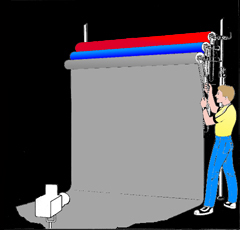Sequence viewing > Light & Lighting - Resource - ©
Lloyd Godman
Light in Photography - LIGHTING - FLASH
LIGHTING -
Photographic BACKGROUNDS
Different
situations may require different backgrounds, but the most common
are white, black and neutral tones. These can either be used as a
drop straight from ceiling to floor or one continuous curved surface
that starts at the ceiling and curves down and out on to the floor.
This curved background can have great advantages because, when it
is much easer to light so that the distinction between floor and wall
dissolve. Large sheets of very stiff paper can be brought for this
purpose or some types of cloth are suitable. Stiff canvas is also
fine depending on the situation as it can be continuously repainted
to suit the situation.
Consider
that whole environments can be created in side the studio. WHAT THE
CAMERA SEES IS WHAT THE PHOTOGRAPH WILL LOOK LIKE. If for example
you attempt create the illusion of a forest scene in the studio the
success of this will depend upon what there image looks like in through
the view finder, not what the studio looks like around you. (The illusion
Hollywood create of a western landscape is isolated in the viewfinder
and is often produced inside a giant barn.)

Move
over image to view roll over image
Want to learn more? - do a workshop or one on one with Lloyd Godman
|